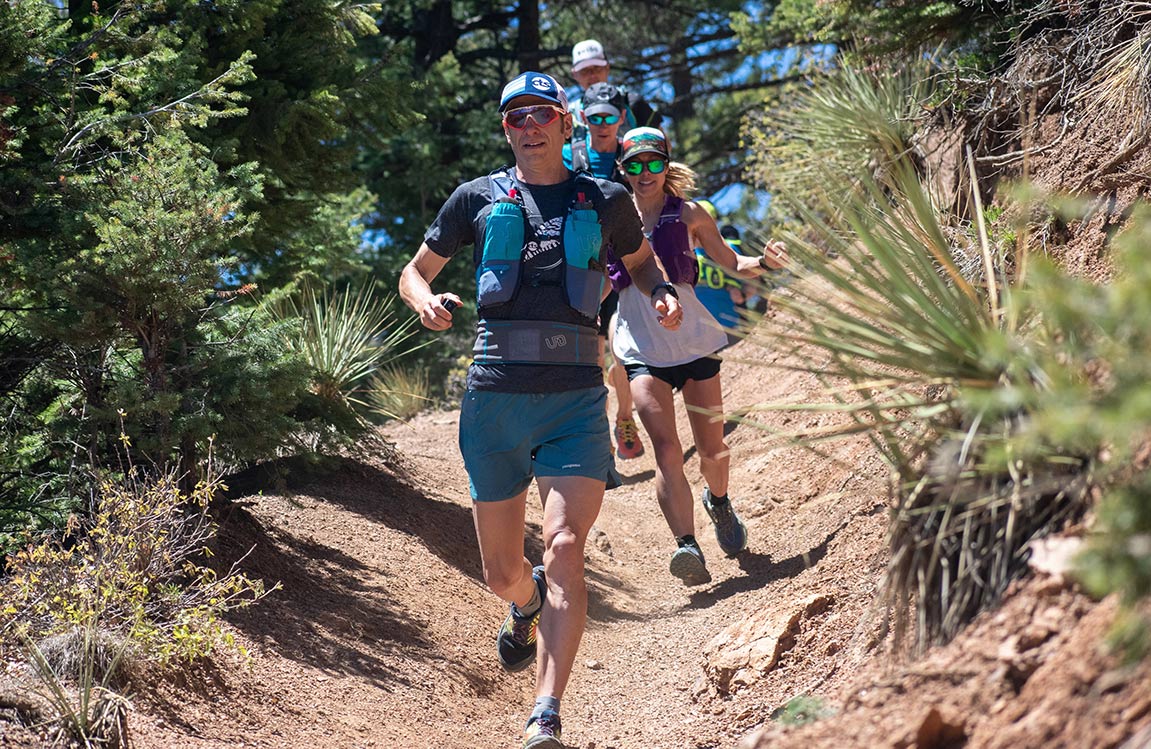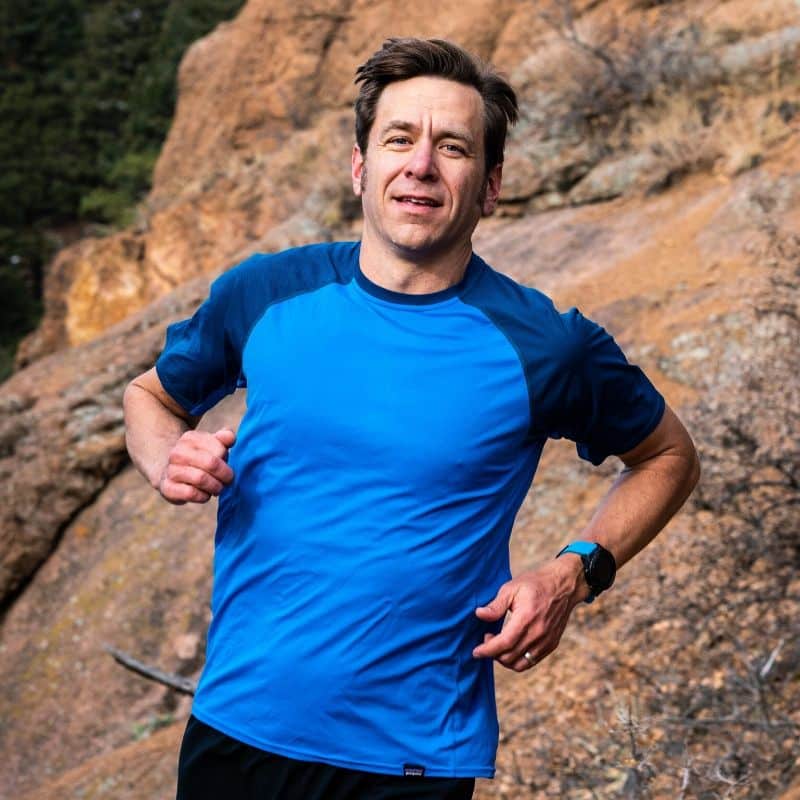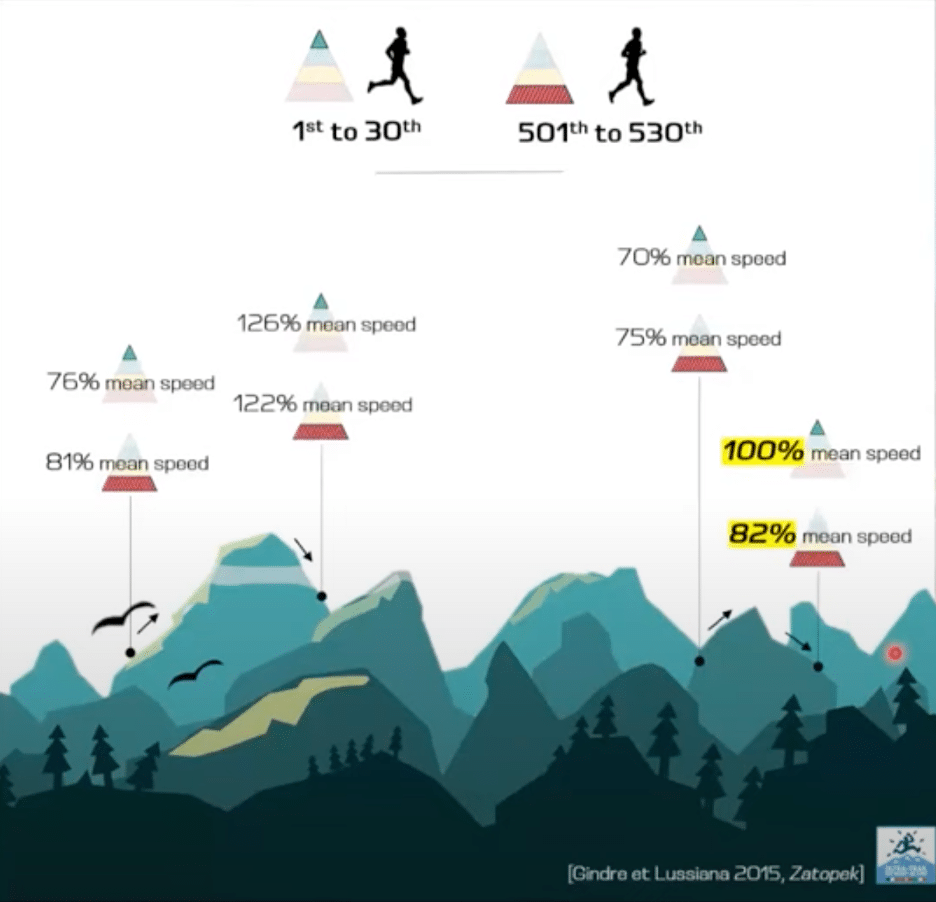
How to Run Downhill Faster in Ultramarathons
The last time I raced Hardrock 100, it delivered a lesson on the value of downhill run training. The high-altitude race is notorious because it features an average elevation of over 11,000 feet and includes more than 32,000 feet of climbing and descending. Every race is a learning experience.
The Hardrock Downhill Story
To provide context for the training guidance to come, I need to start with a story. Most of Hardrock was a struggle for me. The climbs went on endlessly, so slowly the GPS watch won’t even register that you’re moving. One of the better sections, though, was the second to last downhill from Stony Pass into the Cunningham Aid Station.
The descent represents both haven and unholy. It’s a haven because you can finally anticipate seeing your crew after the longest crew-less sections of the course. And you can also take some solace knowing there are only 9 miles to go.
However, any spiritual uplift you feel is immediately exorcised by the ominous view of the 2,400-foot gut punch of a climb that is not-so-aptly named Little Giant. Seriously, it’s a 13,000-foot ridge. It’s like naming the fat guy ‘Tiny’.
I started down the bone-crushing descent to the aid station at what I thought was a reasonable pace. I was fueled by a desire for some Michelin Star-worthy Pringle, avocado, and bacon sandwiches. (How is that NOT on every fine dining menu?) Then, Shinsuke Isomura of Japan flew by me like I was standing still. He passed me half a mile before the Cunningham aid station and subsequently beat me into that aid station by nearly 10 minutes.
For the math geniuses, that means he was skipping and bounding over rocks 20:00 min/mile faster than me. To make it worse, I thought I was running relatively well. Aside from lamenting my lack of athletic prowess, the experience served as a reminder. Although we focus tremendous attention on the uphill side of the ‘vert’ equation, the downhill side is as or more important.
Why Downhills Matter
I have long contended that overall race performance is disproportionally determined by uphill speed. If you improve your climbing by 1% that will be worth more than improving 1% on the downhills. After all, you ascend for more time than you descend. But let’s consider some data.
I was recently reminded of some research, courtesy of Marlene Giandolini (from Salomon’s Sports Science laboratory) and the French running magazine Zatopek. The magazine compared the uphill and downhill speeds of the first 30 and last 30 finishers of UTMB. It was a literal ‘front of the pack to back of the pack’ type comparison. All runners slowed both uphill and downhill as the race progressed. However, the top 30 finishers slowed down remarkably less on the final descent compared to the last 30 finishers.
What does this tell us? The better runners are disproportionally resistant to downhill fatigue vs uphill fatigue when compared to the slower runners. You see this in the chart below. On the final climb, the top 30 and bottom 30 runners are separated by 5% of their mean speed. Yet, on the descent they are separated by a whopping 18%.
All of this being said begs the question, “How do I get better on the downhills?” The answer is two-pronged, and one that we can lean on practice and science for.
Skill Determines Your Best Speed
We typically think of endurance activities like running, cycling, and triathlon as being rooted in cardiopulmonary factors. To a large degree, we can rank hypothetical athletic performance by factors such as VO2 max and Running Economy (the amount of oxygen or energy it takes to run a given speed). We generally see better performance associated with a bigger VO2 max and better the running economy. However, determining the odds on favorites for a downhill race requires a different set of parameters.
We know from previous research that it’s nearly impossible to reach VO2 max on even the slightest of downhill grades (Lemire et al 2020). Now, add to the goulash the fact that running economy, which has long been a king and queen maker in road running, has little performance correlation in mountainous ultras (Pastor et al 2022). Finally, add in the aforementioned UTMB speed profile, where even the best runners are still running at a comfortable pace on the descents. Even the early descents, where they are running 126% of their mean race speed, represent a pace that is far easier than lactate threshold.
So, if the cardiopulmonary system and raw foot speed are largely inconsequential, where does this leave us in terms of how to dominate ultramarathon downhills? We’ll start with skill.
The trail running skills you possess, coupled with risk tolerance, determine the peak speed you can achieve in most downhill situations. For this article I am going to set the risk-taking proposition aside and focus on skills.
Developing Downhill Running Skills
So, what do we know about how to develop skill? Taking a cue from more skill-based sports, skill is developed from refining technique through repetition under low load situations. Think about golfers going to the driving range before hitting the links. They practice different shots repeatedly at the beginning of a training session, then translate those skills to the tees and fairways.
You can find similar examples in other sports, where the skill component (drills or even a practice game) come first and the ‘strength and conditioning’ components second. The idea being to refine the skill as best as possible through repetition while unfatigued.
Ultrarunners can take a cue from this and try to develop trail skill in a similar manner. Fortunately, the solution I propose is simple.
- Find a technical trail.
- Run it repeatedly.
Do this in a ‘low load’ situation at the beginning of the run. Ratchet up the technique by going over the trail faster in subsequent sessions. Or you can find a more technical trail to do over and over (I prefer the latter). In either case, you’re overloading the skill gradually (either though speed or difficulty of the trail).
► Free Ultrarunning Training Assessment Quiz
Take our free 2-minute quiz to discover how effective your training is and get recommendations for how you can improve.
What do you do if you live in a city or don’t have access to technical trails? I’m not sure I have an answer for you. I remained unconvinced that contrived drills you can do in a gym are of much utility (i.e., targeting landing drills or using a speed ladder). While I’d love to present a workaround for city dwellers, I honestly think your time is better spent running more miles as opposed to gaining skill in an artificial manner.
Fatigue Resistance Determines How Much Speed You Can Retain
I have come to appreciate that the uphill component of trail running requires a different training strategy compared to downhill. Traditional endurance indicators, namely the strength of your cardiopulmonary system, determine your uphill prowess. This means the adaptions you seek happen on the order of weeks and months and only after hundreds of hours of training. Intuitively you know this, as you spend months agonizing about how long your longest long run and peak mileage weeks should be.
Contrast that with the downhill side of the performance equation which requires a different set of adaptations. As opposed to being dominated by cardiopulmonary factors, downhill running seems to depend on neural, neuromuscular and musculoskeletal adaptions. In other words, how well your brain can send signals to the muscles, how much that signal fades over time, and the strength of that supporting framework.
Why this stark contrast? It is fundamentally because running uphill primarily involves concentric muscle activation (shortening of the muscle as it is activated). Running downhill eccentric muscle activation (lengthening of the muscle as it is activating). What’s great for trail runners is we know a lot of about how adaptations occur from eccentric exercise.
Eccentric contractions and the Repeated Bout Effect
Scientists have studied the Repeated Bout Effect for more than 40 years. The idea is that one bout of eccentric exercise offers a robust, long-standing adaptation that protects against future bouts of eccentric exercise. This effect is so strong it is sometimes referred to as the ‘inoculation effect’ (i.e., the single bout inoculates you from damage during future bouts). Dr. Fauci, eat your heart out.
Hyperbole aside, it’s hard to find another adaption in exercise science as robust, especially stemming from a single bout of exercise. This was highlighted in recent research out of the University of Calgary by Arash Khasserarash. In the study, they had recreational runners run on a treadmill for 30 minutes at a slope of 20% and a speed of 9:34 min/mile once. They then brought them back into the lab 3 weeks later for the same bout and compared the effects.
Between the tests, they did no running or training of any sorts. Consequently, researchers attributed effects to the single 30-minute downhill run. Despite the relatively simple, singular 30-minute intervention, muscle soreness, neural drive, and loss of maximal voluntary force production were all statistically improved from the first bout to the second bout.
Downhill Run Training Recommendations
Do you think a similar adaption would occur in the uphill condition, where one 30-minute run would produce effects observable weeks later? Not likely. If anything, you would expect to get worse after three weeks off (ask any injured runner).
Enjoying This Article? Get More Free Running Training Tips
Get our coaches' best training advice, delivered straight to your inbox weekly.
Does all this mean you only need to run downhill once to become a downhill beast? Obviously not. However, the literature clearly demonstrates that we must think about training and adaption for downhill in different terms. Namely, adaptions stemming from downhill running can be achieved relatively quickly (on the order of a few sessions) and last for a long period of time (weeks) with little maintenance between the sessions (or none, as Arash’s research indicated).
You should not feel the need to ‘load’ descending in the same way you load overall volume, with systematic progressive increases in load (i.e., increasing your weekly time/mileage). Rather, you can use discreet sessions of descending overload every 2-3 weeks to initiate and maintain adaptations that are specific to downhill performance.
Practical Guide
Here’s how you bring all of this into practice:
- If you can train on terrain similar to that of your upcoming race, simply match the elevation gain/loss per mile to what you will experience on race day. Seriously, if you want to become more fatigue resistant for the downhills, the overload does not need to be high.
- Once per 2-3 weeks, incorporate a session that will exceed your elevation gain/loss per mile by ~10%.
- If you can train on terrain similar to that of your upcoming race, consider a training camp 3-5 weeks before your key event. This option is reasonably accessible and gives you the ability to harness the Repeated Bout Effect. After all, the majority of the adaptations will last at least three weeks.
- If you don’t have the terrain access or the ability to do a camp, periodized strength training that includes heavy lifts might help.
- It’s likely unnecessary to run downhills extremely hard in training, as some coaches have advocated. The research is very clear on this. There is a very low load associated with a robust response to eccentric work.
Summary
Downhill running is different than uphill running and flat running. The adaptations you seek are markedly different parts of your physiology. In order to dominate the downhills, develop better skills and fatigue resistance. Skill acquisition requires repetition on difficult terrain, primarily in an unfatigued state. You can harness fatigue resistance through the Repeated Bout Effect, which requires relatively little effort to produce a robust response. Regardless of whether you have consistent access to the mountains or live in the city with sporadic access to trails, rest assured you can still improve on downhills with some deliberate and targeted work.
By Jason Koop,
CTS Head Ultrarunning Coach



Comments 7
Pingback: Your Ultimate Beginner Ultra Marathon Training Schedule by Time for Hilly Races
Excellent synthetization of Arash Khasserarash’s study and findings. Like cycling or fast hiking or even down-climbing, I believe that there is serious skill involved with the downhills, with the overriding characteristic being confidence vs fear. The less fear you have, the better off you are, if you’ve grown up on trails, hiking in the mountains etc… The problem, that I see and am having right now, is that once you’ve twisted your ankle enough times or hit a root and have gone for a fast flight into a boulder field, you lose that same confidence which make sense, but the fear of falling inhibits the skills and confidence you need to excel at the downhill. That’s me, just riffing, but I love this idea that you’re inoculated after one bout, for three weeks! That means less downhill pounding. At the same time, I’m always curious to understand how much hills and hill repeats are helpful to overall training, particularly for longer, hillier runs. When do we go from running to walking? Is it just an internal decision, or do we wait until we can no longer run up the hill, or is there some smarter way to run the uphills so that we can spread our energy and out over the breath of the run.
Anyway, great article, well written, practical applications and you’re awesome. Thank you. Erin Quinn
Öz Klima Servisi olarak İstanbul genelinde klima montajı,klima tamiri,petek temizliği,klima bakımı gibi hizmetlerimiz mevcuttur.İşletmemiz 100% orjinal ürünler kullanıp uzman teknisyenlerimiz tarafından gerçekleşmektedir.
https://www.ozklimaservisi.com/
Does anyone have any suggestions for athletes who experience severe quad pain on the descents, even after having trained on the course for months in advance? The race is technical, in November with temps about 45-55, and has very steep ascents followed by very steep descents. The pain is sudden and every step after it starts is torture. It can improve somewhat if I keep moving but I would like to avoid this from happening ever again!
By your description this sounds like a question for a doctor or physiotherapist to answer.
Perhaps a biomechanical issue. Maybe a nerve getting pinched. I don’t know.
I advise you to see a specialist.
Ups! That is quiet a u-turn! For years we have been hearing in podcasts and read in other materials that the focus should always be on uphill training. The argument was that one spends much more time on the uphill then on the downhill. Downhill training was sometimes classified as a waste of time.
Fortunately, I have known all along about the importance of downhill. Consequently, I included some downhill specific workouts in my runner’s schedules.
Thank you! at 70+yr I am still trying to improve:)